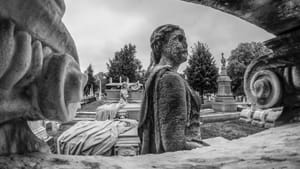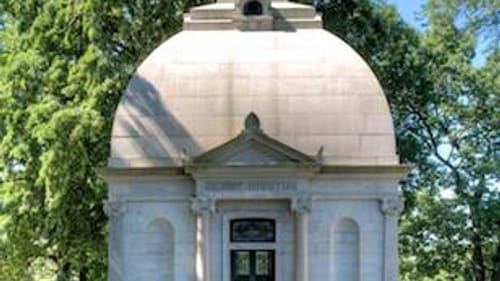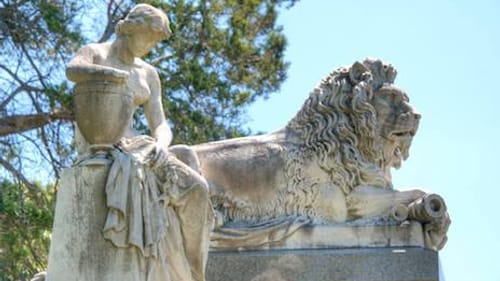Stay in the Loop
BSR publishes on a weekly schedule, with an email newsletter every Wednesday and Thursday morning. There’s no paywall, and subscribing is always free.
Life after death
Take a tour with Laurel Hill Cemetery's new mobile app

When I asked my mother to accompany me as I tested out Laurel Hill Cemetery’s new mobile app, she exclaimed: “Sure! I’ve always been attracted to walking in cemeteries. The art, the tombstones, the images, the epitaphs — they spark the imagination.” Blame it on watching Hocus Pocus one too many times as a child, but I’ve always found cemeteries creepy. Here lies Johnny Smith… right here, right in front of you, just six feet underground. My mom, however, has a different perspective.
To her, Johnny Smith lies here offering a glimpse into a particular time and place in the past. Who was Johnny? What was life like then? We hoped the app could tell us some good ghost stories.
Haunting aesthetics
When we pulled through the grand columns of the cemetery’s historic gatehouse, my phone suddenly started streaming the sounds of an eight-piece string ensemble. If you opt to turn on location notifications, the mobile app’s GPS-enabled map triggers an original music score and narration whenever you approach one of the 37 unique stops along the site’s 78 acres.
“As you walk through Laurel Hill’s massive gatehouse,” a woman’s voice softly guided us, “take a moment to experience its wonderful architecture.” Our self-guided tour of the national landmark and our nation’s second major garden cemetery had begun.
Be warned, though: the app’s design isn’t glamorous. If you’re hoping for fancy bells and whistles, you will not find them amid its muted colors and chunky, rectangular layout. Simple footer navigation provides access to information in plain text, reminiscent of iPhone’s Notes app.
Complementary historical images are paired with each tour stop, but they only occupy the top third of the screen and you cannot zoom, so it can be hard to see details. There is an option to select from one of 18 languages but it only adjusts superficial text (not the actual audio recordings and transcriptions), so the bulk of the app is not very accessible for non-English speakers and readers.

Killer content
However, what the app sacrifices in design it more than makes up for in content. Using the cemetery’s free wifi (remember to stop into the offices at the gatehouse to get the password!), you can select one of three curated tours: Art and Architecture, Pop Culture and Contemporary Stories, or Lore and Legend. Each tour features more than a dozen stops where you can listen to a two-to-five-minute voice narration with interesting facts and tidbits as well as a little cemetery lore.
We chose to follow the GPS map at our leisure. Strolling along the paved paths at our own pace, the app allowed us to discover fascinating stories of significant people, art, and architecture.
We saluted the bronze, seven-foot-tall Silent Sentry, which, the app informed us, was initially located in Southwest Philadelphia. After its recovery after a theft in the 1970s, the sentry was relocated to Laurel Hill where he now guards the gravesites of several Civil War veterans.
We marveled at “Millionaires’ Row,” where a cluster of mausoleums house several historic industrial moguls, including Henry Disston, an “industrial-saw manufacturer extraordinaire and the go-to guy for hand saws in the 1800s.” His mausoleum is the cemetery’s largest and overlooks the Schuylkill River. If you peer through a paned window in the front door, you’ll notice a small piece of stained glass toward the back that sparkles in the afternoon sun.

Meet the locals
We met many other legendary and famed personalities, including local boldfaced names such as Rittenhouse and Widener, as well as national figures such as General Robert Patterson and several Titanic passengers. Each stop connects their stories to the City of Brotherly Love.
Admirably, the tour also mentions connections to other nonprofits and organizations. Matthias Baldwin of the renowned Baldwin Locomotive, whose “Baldwin 60000” train is on permanent display at the Franklin Institute, is buried here. Laurel Hill’s designer, architect John Notman, also designed the Athenaeum of Philadelphia on Washington Square.
Somewhat less luminary but still notable is the gravesite of Adrienne Balboa, the wife of Philly’s favorite fictional boxer, Rocky Balboa.
According to Nick McAllister, the cemetery’s director of development and membership, the mobile app “serve[s] as a teaser to get people hooked on the cemetery and to want to come back to hear more of the stories we have to tell and the unique events we have to offer.”
Founded in 1836, Laurel Hill Cemetery was historically a space that served not only as a final resting place for the dead but as an area of relaxation and recreation for the living. With the recent addition of this app, at once an engaging history lesson and an exercise in imagination, it has already succeeded in enticing this scaredy-cat to return for more stories.
What, When, Where
Laurel Hill Cemetery, 3822 Ridge Avenue, Philadelphia. (215) 228-8200. Free mobile app available for download at thelaurelhillcemetery.org/visit/mobile or at the Google and Apple app stores.
Sign up for our newsletter
All of the week's new articles, all in one place. Sign up for the free weekly BSR newsletters, and don't miss a conversation.
 Brittany Barbato
Brittany Barbato